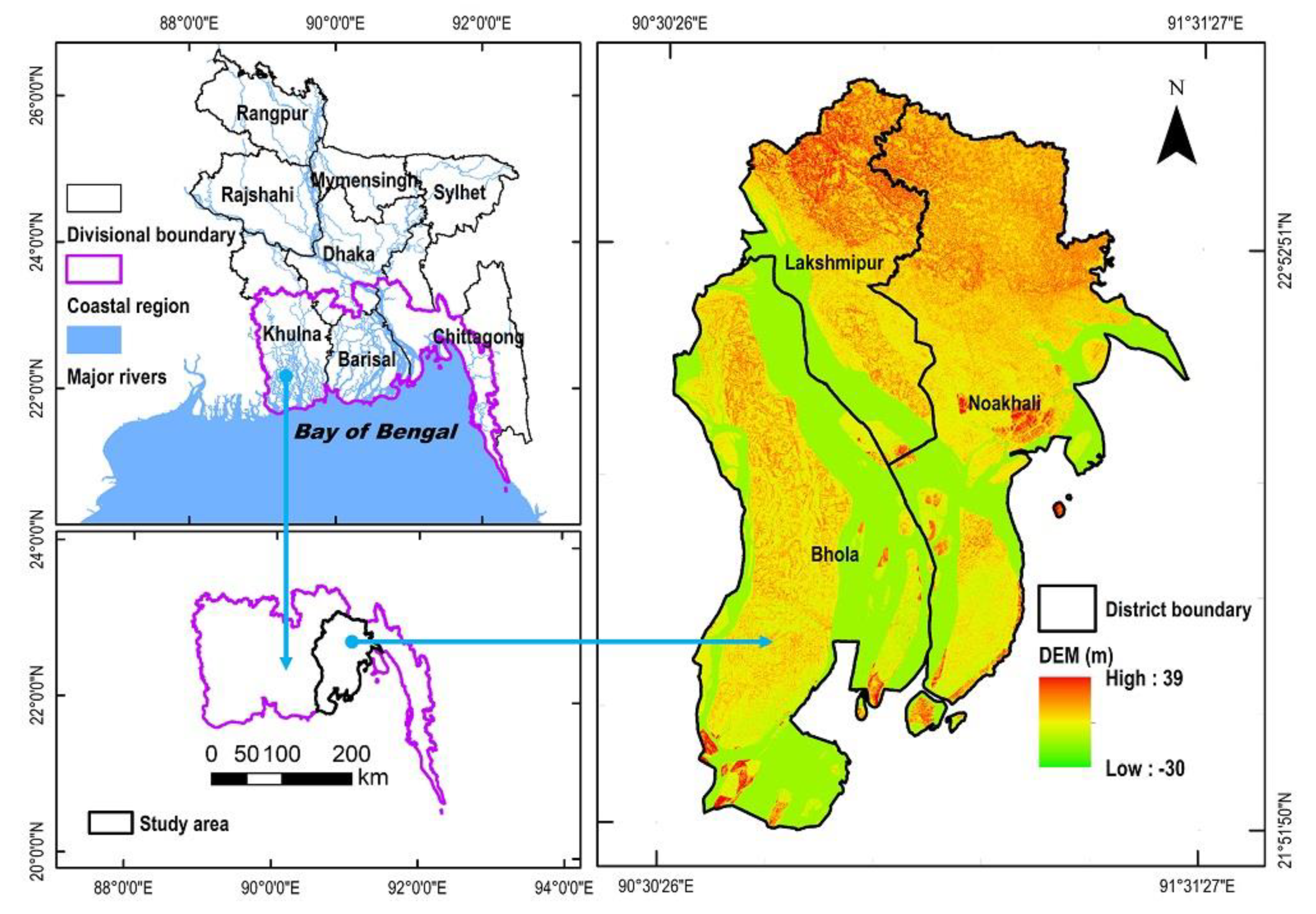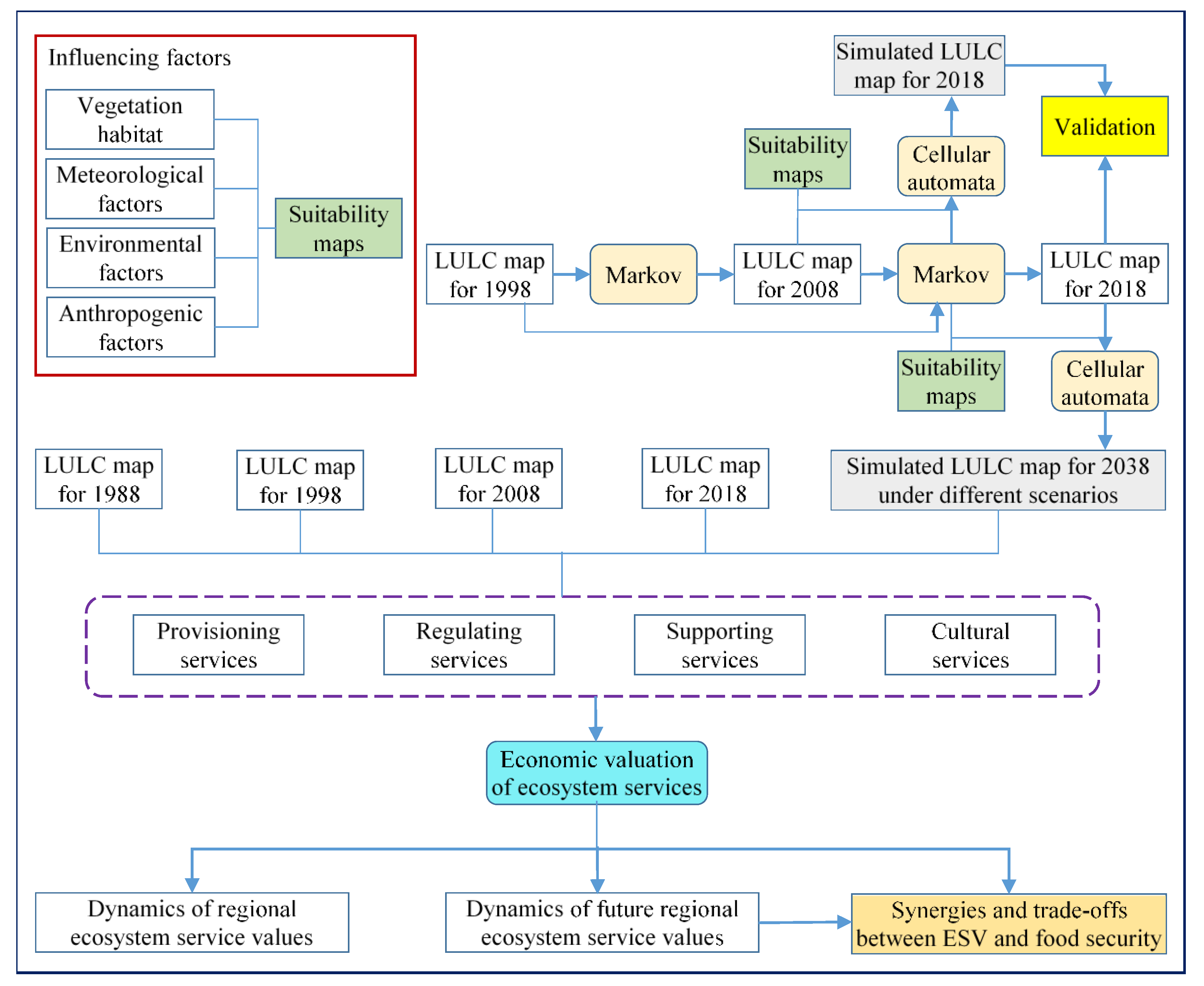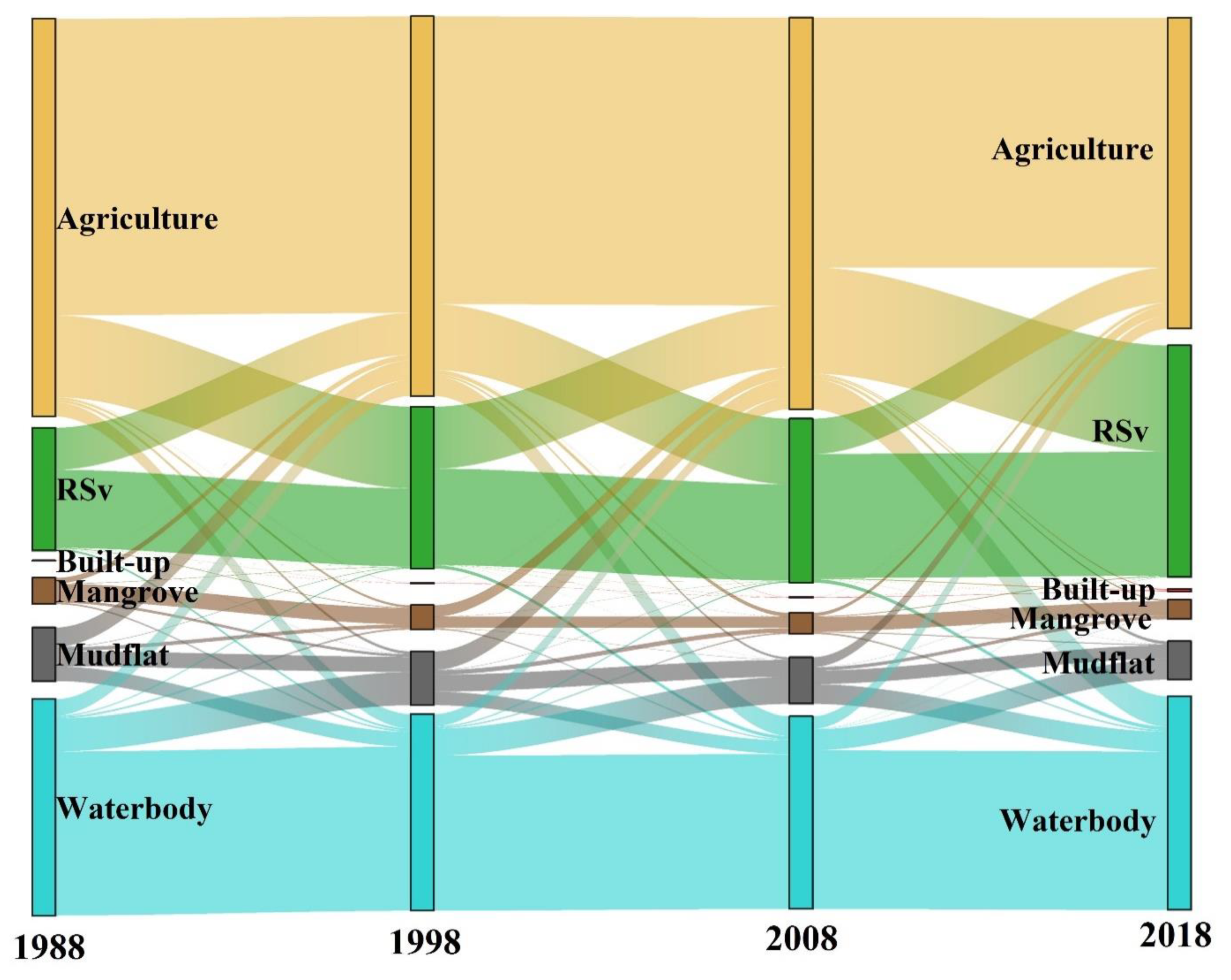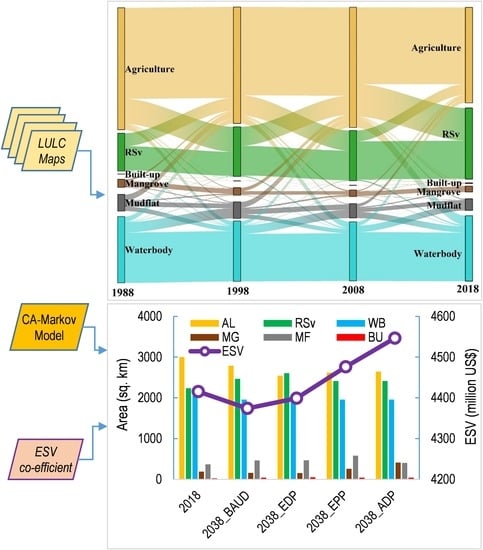Future Impact of Land Use/Land Cover Changes on Ecosystem Services in the Lower Meghna River Estuary, Bangladesh
Abstract
1. Introduction
2. Materials and Methods
2.1. Study Area
2.2. Data Acquisition and Processing
2.3. LULC Classification
2.4. LULC Prediction
2.4.1. Development of Suitability Maps
2.4.2. LULC Map Simulation and Validation
2.5. Assignment of Ecosystem Service Values
2.6. Calculation of ESV
3. Results and Analysis
3.1. LULC Changes during 1988–2018
3.2. LULC Changes during 2018–2038 under Different Scenarios
3.3. Changes in ESV during 1988–2018
3.4. Effects of Future Land Management Scenarios on Subsequent Changes in ESVs
4. Discussion
4.1. Trade-offs between ESVs and Regional Food Security
4.2. Implications for Future Land Management in the LMRE
4.3. Limitations of the Study and Potential Uncertainties
5. Conclusions
Supplementary Materials
Author Contributions
Funding
Acknowledgments
Conflicts of Interest
References
- Yirsaw, E.; Wu, W.; Shi, X.; Temesgen, H.; Bekele, B. Land Use/Land Cover Change Modeling and the Prediction of Subsequent Changes in Ecosystem Service Values in a Coastal Area of China, the Su-Xi-Chang Region. Sustainability 2017, 9, 1204. [Google Scholar] [CrossRef]
- Sun, X.; Crittenden, J.; Li, F.; Lu, Z.; Dou, X. Urban expansion simulation and the spatio-temporal changes of ecosystem services, a case study in Atlanta Metropolitan area, USA. Sci. Total. Environ. 2018, 622, 974–987. [Google Scholar] [CrossRef] [PubMed]
- Estoque, R.C.; Murayama, Y. Examining the potential impact of land use/cover changes on the ecosystem services of Baguio city, the Philippines: A scenario-based analysis. Appl. Geogr. 2012, 35, 316–326. [Google Scholar] [CrossRef]
- Sahle, M.; Saito, O.; Fürst, C.; Demissew, S.; Yeshitela, K. Future land use management effects on ecosystem services under different scenarios in the Wabe River catchment of Gurage Mountain chain landscape, Ethiopia. Sustain. Sci. 2018, 14, 175–190. [Google Scholar] [CrossRef]
- Zhao, M.; He, Z.; Du, J.; Chen, L.; Lin, P.; Fang, S. Assessing the effects of ecological engineering on carbon storage by linking the CA-Markov and InVEST models. Ecol. Indic. 2019, 98, 29–38. [Google Scholar] [CrossRef]
- Hu, Y.; Gao, M. Batunacun Evaluations of water yield and soil erosion in the Shaanxi-Gansu Loess Plateau under different land use and climate change scenarios. Environ. Dev. 2019, 100488. [Google Scholar] [CrossRef]
- Millennium Ecosystem Assessment, M.E.A. Ecosystems and human well-being. Synthesis 2005, 5, 563. [Google Scholar]
- Huq, N.; Bruns, A.; Ribbe, L. Interactions between freshwater ecosystem services and land cover changes in southern Bangladesh: A perspective from short-term (seasonal) and long-term (1973–2014) scale. Sci. Total. Environ. 2019, 650, 132–143. [Google Scholar] [CrossRef]
- Costanza, R.; d’Arge, R.; De Groot, R.; Farber, S.; Grasso, M.; Hannon, B.; Limburg, K.; Naeem, S.; O’neill, R.V.; Paruelo, J.; et al. The value of the world’s ecosystem services and natural capital. Nature 1997, 387, 253–260. [Google Scholar] [CrossRef]
- Arowolo, A.O.; Deng, X.; Olatunji, O.A.; Obayelu, A.E. Assessing changes in the value of ecosystem services in response to land-use/land-cover dynamics in Nigeria. Sci. Total. Environ. 2018, 636, 597–609. [Google Scholar] [CrossRef]
- Akber, A.; Khan, W.R.; Islam, A.; Rahman, M.; Rahman, M.R. Impact of land use change on ecosystem services of southwest coastal Bangladesh. J. Land Use Sci. 2018, 13, 1–13. [Google Scholar] [CrossRef]
- Nor, A.N.M.; Corstanje, R.; Harris, J.; Brewer, T. Impact of rapid urban expansion on green space structure. Ecol. Indic. 2017, 81, 274–284. [Google Scholar] [CrossRef]
- Basse, R.M.; Omrani, H.; Charif, O.; Gerber, P.; Bodis, K. Land use changes modelling using advanced methods: Cellular automata and artificial neural networks. The spatial and explicit representation of land cover dynamics at the cross-border region scale. Appl. Geogr. 2014, 53, 160–171. [Google Scholar] [CrossRef]
- Hoque, M.Z.; Cui, S.; Xu, L.; Islam, I.; Ali, G.; Tang, J. Resilience of coastal communities to climate change in Bangladesh: Research gaps and future directions. Watershed Ecol. Environ. 2019, 1, 42–56. [Google Scholar] [CrossRef]
- Abdullah, A.Y.M.; Masrur, A.; Adnan, M.S.G.; Al Baky, A.; Hassan, Q.K.; Dewan, A. Spatio-temporal Patterns of Land Use/Land Cover Change in the Heterogeneous Coastal Region of Bangladesh between 1990 and 2017. Remote. Sens. 2019, 11, 790. [Google Scholar] [CrossRef]
- BBS. Statistical Yearbook of Bangladesh: Bangladesh Bureau of Statistics (BBS); Ministry of Planning: Dhaka, Bangladesh, 2018.
- Hasan, S.S.; Deng, X.; Li, Z.; Chen, D. Projections of Future Land Use in Bangladesh under the Background of Baseline, Ecological Protection and Economic Development. Sustainability 2017, 9, 505. [Google Scholar] [CrossRef]
- World Economic Forum. Here’s what you need to know about Bangladesh’s rocketing economy. Available online: https://www.weforum.org/agenda/2019/11/bangladesh-gdp-economy-asia/ (accessed on 24 February 2020).
- Islam, M.R.; Miah, M.G.; Inoue, Y. Analysis of Land use and Land Cover Changes in the Coastal Area of Bangladesh using Landsat Imagery. Land Degrad. Dev. 2015, 27, 899–909. [Google Scholar] [CrossRef]
- Hoque, M.Z.; Cui, S.; Xu, L.; Islam, I.; Tang, J.; Ding, S. Assessing Agricultural Livelihood Vulnerability to Climate Change in Coastal Bangladesh. Int. J. Environ. Res. Public Heal. 2019, 16, 4552. [Google Scholar] [CrossRef]
- Ahmed, A.; Drake, F.; Nawaz, R.; Woulds, C. Where is the coast? Monitoring coastal land dynamics in Bangladesh: An integrated management approach using GIS and remote sensing techniques. Ocean Coast. Manag. 2018, 151, 10–24. [Google Scholar] [CrossRef]
- Ahmed, A.; Nawaz, R.; Drake, F.; Woulds, C. Modelling land susceptibility to erosion in the coastal area of Bangladesh: A geospatial approach. Geomorphol. 2018, 320, 82–97. [Google Scholar] [CrossRef]
- Nicholls, R.J.; Hutton, C.W.; Adger, W.N.; Hanson, S.E.; Rahman, M.M.; Salehin, M. (Eds.) Ecosystem Services for Well-Being in Deltas: Integrated Assessment for Policy Analysis; Palgrave Macmillan: Basingstoke, UK, 2018. [Google Scholar]
- Iftekhar, M.S.; Takama, T. Perceptions of biodiversity, environmental services, and conservation of planted mangroves: a case study on Nijhum Dwip Island, Bangladesh. Wetl. Ecol. Manag. 2007, 16, 119–137. [Google Scholar] [CrossRef]
- Chow, J. Determinants of household fuelwood collection from mangrove plantations in coastal Bangladesh. For. Policy Econ. 2018, 96, 83–92. [Google Scholar] [CrossRef]
- BBS. Statistical yearbook of Bangladesh: Bangladesh Bureau of Statistics (BBS); Ministry of Planning: Dhaka, Bangladesh, 2011.
- Syed, Z.H.; Choi, G.; Byeon, S. A Numerical Approach to Predict Water Levels in Ungauged Regions—Case Study of the Meghna River Estuary, Bangladesh. Water 2018, 10, 110. [Google Scholar] [CrossRef]
- Congedo, L. Semi-Automatic Classification Plugin Documentation. 2013. Available online: https://www.researchgate.net/publication/265020952_Semi-Automatic_Classification_Plugin_for_QGIS (accessed on 24 February 2020).
- MoEFCC. The submission of Bangladesh’s forest reference level for REDD+ under the UNFCCC; Ministry of Environment, Forest and Climate Change (MoEFCC), Government of Bangladesh: Dhaka, Bangladesh, 2018. Available online: https://redd.unfccc.int/files/2019_submission_frel_bangladesh.pdf (accessed on 24 February 2020).
- Gong, W.; Yuan, L.; Fan, W.; Stott, P.G. Analysis and simulation of land use spatial pattern in Harbin prefecture based on trajectories and cellular automata—Markov modelling. Int. J. Appl. Earth Obs. Geoinformation 2015, 34, 207–216. [Google Scholar] [CrossRef]
- Saaty, T.L. Decision making with the analytic hierarchy process. Int. J. Serv. Sci. 2008, 1, 83–98. [Google Scholar] [CrossRef]
- Goepel, K.D. Implementing the Analytic Hierarchy Process as a Standard Method for Multi-Criteria Decision Making in Corporate Enterprises—a New AHP Excel Template with Multiple Inputs. In Proceedings of the international symposium on the analytic hierarchy process 2013, Kualalampur, Malaysia, 23–26 June 2013. [Google Scholar]
- Poska, A.; Sepp, E.; Veski, S.; Koppel, K. Using quantitative pollen-based land-cover estimations and a spatial CA_Markov model to reconstruct the development of cultural landscape at R õuge, South Estonia. Veg. Hist. Archaeobotany 2007, 17, 527–541. [Google Scholar] [CrossRef]
- Gashaw, T.; Tulu, T.; Argaw, M.; Worqlul, A.W.; Tolessa, T.; Kindu, M. Estimating the impacts of land use/land cover changes on Ecosystem Service Values: The case of the Andassa watershed in the Upper Blue Nile basin of Ethiopia. Ecosyst. Serv. 2018, 31, 219–228. [Google Scholar] [CrossRef]
- Zhang, F.; Yushanjiang, A.; Jing, Y. Assessing and predicting changes of the ecosystem service values based on land use/cover change in Ebinur Lake Wetland National Nature Reserve, Xinjiang, China. Sci. Total. Environ. 2019, 656, 1133–1144. [Google Scholar] [CrossRef]
- Plummer, M.L. Assessing benefit transfer for the valuation of ecosystem services. Front. Ecol. Environ. 2009, 7, 38–45. [Google Scholar] [CrossRef]
- Yi, H.; Güneralp, B.; Filippi, A.M.; Kreuter, U.P.; Guneralp, I. Impacts of Land Change on Ecosystem Services in the San Antonio River Basin, Texas, from 1984 to 2010. Ecol. Econ. 2017, 135, 125–135. [Google Scholar] [CrossRef]
- De Groot, R.; Brander, L.; Van Der Ploeg, S.; Costanza, R.; Bernard, F.; Braat, L.; Christie, M.; Crossman, N.; Ghermandi, A.; Hein, L.; et al. Global estimates of the value of ecosystems and their services in monetary units. Ecosyst. Serv. 2012, 1, 50–61. [Google Scholar] [CrossRef]
- Ullah, M.; Mondal, M.; Atiqul, I.; Uddin, M.; Ferdous, M. Implications of Mangrove Wetland in Socio-environmental Sector: Experiences from Southeast Coast of Chittagong, Bangladesh. JFES 2010, 26, 103–111. [Google Scholar]
- Chow, J. Spatially Explicit Evaluation of Local Extractive Benefits from Mangrove Plantations in Bangladesh. J. Sustain. For. 2015, 34, 651–681. [Google Scholar] [CrossRef]
- Chen, Y.; Lyu, C. A Comparative Analysis on Food Security in Bangladesh, India and Myanmar. Sustainability 2018, 10, 405. [Google Scholar] [CrossRef]
- Chowdhury, A.; Haque, M.; Hoque, M.; Rokonuzzam, M. Adoption of BRRI Dhan47 in the Coastal Saline areas of Bangladesh. Agric. J. 2012, 7, 286–291. [Google Scholar] [CrossRef]
- Khalil, I.; Haque, E.; Hoque, M.Z. Adoption of recommended potato (Solanum tuberosum) production technologies by the potato growers of some selected areas of Bangladesh. Bangladesh J. Agric. Res. 2014, 39, 79–92. [Google Scholar] [CrossRef]
- Kindu, M.; Schneider, T.; Teketay, D.; Knoke, T. Changes of ecosystem service values in response to land use/land cover dynamics in Munessa–Shashemene landscape of the Ethiopian highlands. Sci. Total. Environ. 2016, 547, 137–147. [Google Scholar] [CrossRef]
- Junior, R.F.V.; Varandas, S.G.; Pacheco, F.A.L.; Pereira, V.; Santos, C.; Cortes, R.M.; Fernandes, L.F.S. Impacts of land use conflicts on riverine ecosystems. Land Use Policy 2015, 43, 48–62. [Google Scholar] [CrossRef]





| LULC Type | Description |
|---|---|
| Agricultural land | Cultivated and uncultivated farmlands |
| Rural settlement with vegetation (RSv) | Homestead vegetation, tree canopy on and around rural settlements, orchard, tree plantation or woodlands |
| Mangrove forest | Wetland area covered with dense forests both natural and planted |
| Mudflat | Coastal flat, coastal marsh, newly accreted land |
| Built-up land | Residential, commercial, and industrial sites, exposed roads (highways), and other urban forms |
| Water body | Rivers, canals, and other active hydrological features |
| Function | Services | ESV/(US$ ha−1yr−1) | |||||
|---|---|---|---|---|---|---|---|
| AL a | RSv b | MG c | MF d | BU e | WB f | ||
| Provisioning | Food production | 922 | 357 | 250 | 135 | 0 | 603 |
| Raw material | 317 | 211 | 27 | 27 | 0 | 423 | |
| Regulating | Extreme event management | 78 | 78 | 2500 | 272 | 78 | 233 |
| Climate regulation | 426 | 533 | 1140 | 853 | 0 | 533 | |
| Water regulation | 958 | 1277 | 579.3 | 2555 | 0 | 2555 | |
| Supporting | Biodiversity protection | 333 | 499 | 4400 | 499 | 0 | 499 |
| Soil formation and retention | 141 | 141 | 1650 | 212 | 0 | 141 | |
| Waste treatment | 1103 | 1103 | 760 | 1930 | 0 | 2206 | |
| Cultural | Recreation, culture and tourism | 261 | 261 | 550 | 392 | 392 | 457 |
| Total | 4539 | 4461 | 11,856 | 6874 | 470 | 7649 | |
| Scenarios | LULC Type | 2038 | ||||||
|---|---|---|---|---|---|---|---|---|
| AL a | RSv b | MG c | MF d | BU e | WB f | |||
| BAUD | 2018 | AL | 2353.5 | 279.0 | 33.1 | 78.5 | 1.4 | 45.7 |
| RSv | 572.0 | 1848.9 | 40.6 | 1.9 | 1.2 | 1.1 | ||
| MG | 1.5 | 0.3 | 115.4 | 27.8 | 0.0 | 14.1 | ||
| MF | 5.2 | 0.1 | 0.1 | 261.3 | 0.0 | 196.8 | ||
| BU | 8.3 | 14.0 | 0.0 | 0.0 | 20.8 | 0.1 | ||
| WB | 59.9 | 94.5 | 0.5 | 1.3 | 0.2 | 1803.2 | ||
| EDP | 2018 | AL | 2211.4 | 245.7 | 30.9 | 37.6 | 0.9 | 21.9 |
| RSv | 663.8 | 1910.9 | 17.1 | 9.2 | 1.4 | 2.4 | ||
| MG | 1.1 | 0.7 | 136.1 | 15.0 | 0.0 | 3.8 | ||
| MF | 11.5 | 0.1 | 1.6 | 305.1 | 0.0 | 153.0 | ||
| BU | 11.9 | 15.9 | 0.1 | 0.2 | 21.3 | 0.2 | ||
| WB | 100.7 | 63.4 | 3.7 | 3.8 | 0.1 | 1879.7 | ||
| EPP | 2018 | AL | 2309.2 | 279.5 | 0.0 | 0.0 | 1.4 | 33.0 |
| RSv | 569.9 | 1843.6 | 0.0 | 0.0 | 1.2 | 0.7 | ||
| MG | 24.8 | 2.9 | 189.4 | 29.7 | 0.0 | 13.9 | ||
| MF | 29.8 | 3.0 | 0.1 | 340.9 | 0.0 | 206.7 | ||
| BU | 8.3 | 14.0 | 0.0 | 0.0 | 20.8 | 0.1 | ||
| WB | 58.5 | 93.8 | 0.2 | 0.3 | 0.2 | 1806.6 | ||
| ADP | 2018 | AL | 2331.9 | 280.2 | 0.0 | 0.0 | 1.4 | 33.2 |
| RSv | 569.9 | 1844.9 | 0.0 | 0.0 | 1.2 | 0.7 | ||
| MG | 9.9 | 1.2 | 189.3 | 160.5 | 0.0 | 52.5 | ||
| MF | 21.8 | 2.7 | 0.0 | 210.0 | 0.0 | 168.3 | ||
| BU | 8.3 | 14.0 | 0.0 | 0.0 | 20.8 | 0.1 | ||
| WB | 58.7 | 93.8 | 0.3 | 0.3 | 0.2 | 1806.3 | ||
| LULC Scenarios | LULC Type Changes during 2018–2038 (km2) | ESVs Change (106 US$) | Food Grain Production Reduced (million ton) | Food Gap (%) | |||||
|---|---|---|---|---|---|---|---|---|---|
| AL a | RSv b | MG c | MF d | BU e | WB f | ||||
| BAUD | −211.17 | 229.03 | −30.51 | 92.66 | 19.48 | −99.49 | −41.37 | −0.14 | −1.65 |
| EDP | −453.88 | 368.06 | −32.82 | 100.40 | 25.88 | −7.62 | −16.38 | −0.30 | −10.21 |
| EPP | −379.22 | 178.65 | 70.98 | 209.62 | 19.45 | −99.49 | 60.61 | −0.25 | −7.58 |
| ADP | −355.67 | 179.95 | 223.82 | 31.94 | 19.45 | −99.49 | 130.95 | −0.23 | −6.75 |
© 2020 by the authors. Licensee MDPI, Basel, Switzerland. This article is an open access article distributed under the terms and conditions of the Creative Commons Attribution (CC BY) license (http://creativecommons.org/licenses/by/4.0/).
Share and Cite
Hoque, M.Z.; Cui, S.; Islam, I.; Xu, L.; Tang, J. Future Impact of Land Use/Land Cover Changes on Ecosystem Services in the Lower Meghna River Estuary, Bangladesh. Sustainability 2020, 12, 2112. https://doi.org/10.3390/su12052112
Hoque MZ, Cui S, Islam I, Xu L, Tang J. Future Impact of Land Use/Land Cover Changes on Ecosystem Services in the Lower Meghna River Estuary, Bangladesh. Sustainability. 2020; 12(5):2112. https://doi.org/10.3390/su12052112
Chicago/Turabian StyleHoque, Muhammad Ziaul, Shenghui Cui, Imranul Islam, Lilai Xu, and Jianxiong Tang. 2020. "Future Impact of Land Use/Land Cover Changes on Ecosystem Services in the Lower Meghna River Estuary, Bangladesh" Sustainability 12, no. 5: 2112. https://doi.org/10.3390/su12052112
APA StyleHoque, M. Z., Cui, S., Islam, I., Xu, L., & Tang, J. (2020). Future Impact of Land Use/Land Cover Changes on Ecosystem Services in the Lower Meghna River Estuary, Bangladesh. Sustainability, 12(5), 2112. https://doi.org/10.3390/su12052112






